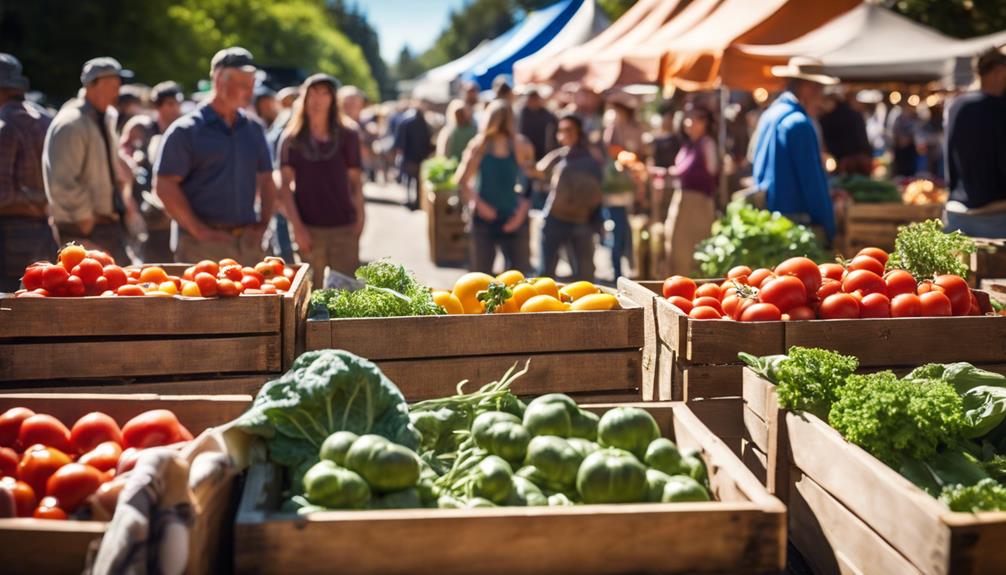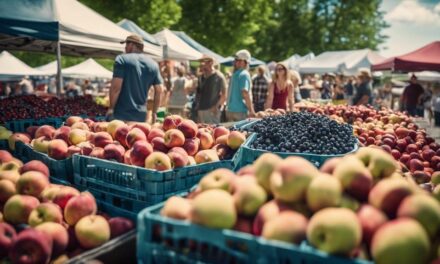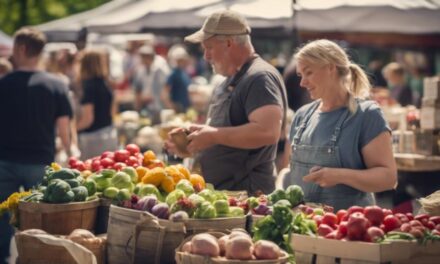When you're at the farmers market, maneuvering through the myriad of stalls can feel overwhelming, especially if you're aiming to buy organic veggies. It's important to inquire about farming practices to make sure you're getting truly organic produce. Notice the natural appearances—variations in shape and minor blemishes often indicate minimal pesticide use. Plan your purchases around what's in season for peak freshness and better prices. Setting a budget will help you stay cost-effective, and don't overlook markdown items—they can be a fantastic value. Curious about how to make the most of these strategies? Let's explore each tip further.
Key Takeaways
- Ask farmers about their pesticide use, farming methods, and USDA organic certification.
- Look for natural irregularities, varying shapes, and minor blemishes in produce.
- Shop for seasonal produce for the best freshness and prices.
- Set a budget and track spending, looking for deals or markdowns.
- Utilize markdown items for soups, sauces, or freezing to reduce food waste.
Ask About Farming Practices
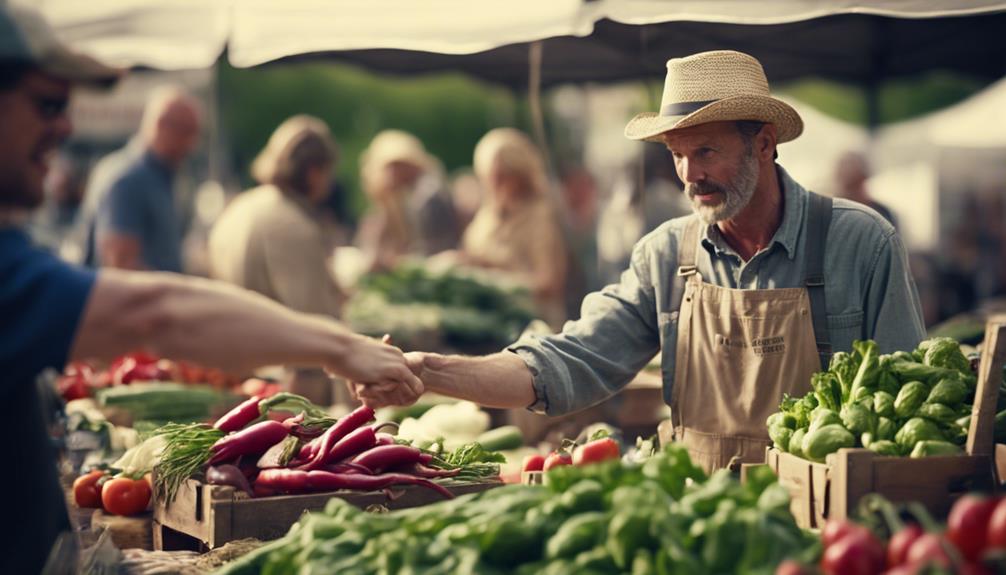
When visiting your local farmers market, make it a priority to ask farmers directly about their farming practices to confirm you're getting genuinely organic produce. Understanding the specifics of how your food is grown can make a significant difference in confirming its quality and integrity.
Start by inquiring about their pesticide use and farming methods. True organic farming avoids synthetic pesticides, focusing instead on natural alternatives to manage pests and diseases.
Don't hesitate to ask if the produce is USDA organic certified. This certification guarantees that the food meets strict standards set by the USDA, including soil quality and production methods, and that the land has been free of prohibited substances for at least three years.
However, keep in mind that many local farmers may practice organic farming without formal certification. This is often due to the high costs and rigorous processes involved in obtaining the certification.
Instead, probe into their sustainable growing practices. Sustainable methods often include crop rotation, natural composting, and the use of cover crops to maintain soil health and fertility. These practices contribute to the long-term health of the environment and ensure the produce you're consuming is free from harmful chemicals.
Look for Natural Appearances
You can often identify genuinely organic veggies by their natural irregularities, such as varying shapes and sizes. When you're browsing through the local farmers market, keep an eye out for produce that doesn't look uniformly perfect. In organic farming, the absence of synthetic pesticides and fertilizers means that fruits and veggies grow in their natural forms, often with unique quirks and imperfections.
Spotting these natural appearances can be a game-changer. Look for veggies with minor blemishes or insect damage—these are signs that no harmful chemicals were used to keep pests away. Organic produce can also have a duller surface compared to the shiny, waxy look of conventionally farmed vegetables, which might've been treated with chemical coatings to enhance their appearance.
When you're at the market, take a moment to appreciate the variety. Notice how the tomatoes aren't all the same size, and the carrots might've interesting twists and turns. This diversity indicates a healthy, sustainable farming practice. Instead of reaching for the perfect-looking items, embrace the beauty of natural growth.
Doing a bit of homework before you go can also help. Make a list of what's in season, as seasonal produce is more likely to be fresh and locally sourced. By choosing seasonal items, you support local farmers and reduce the carbon footprint associated with transporting out-of-season produce.
Plan Purchases by Season
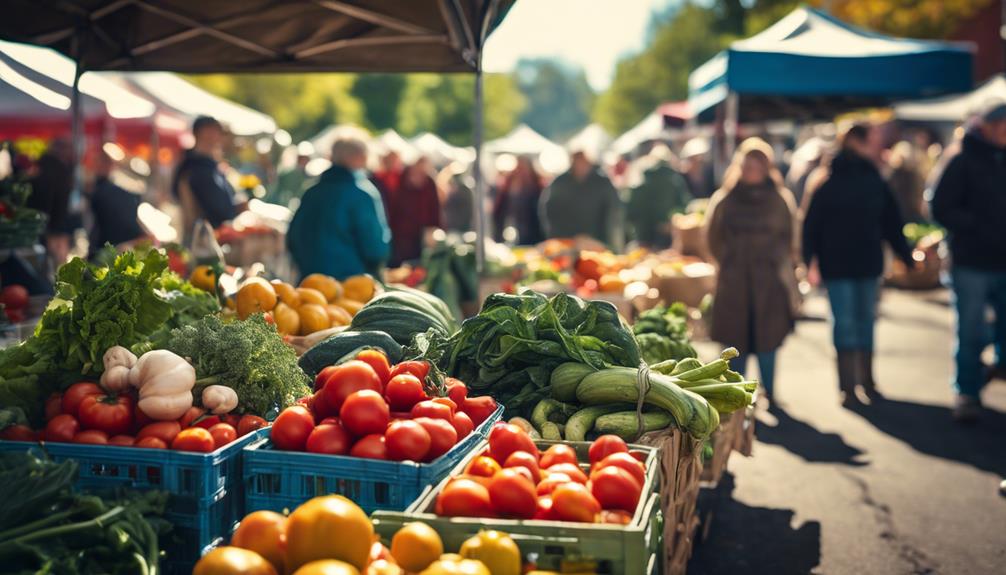
Understanding which vegetables are in season can greatly enhance your farmers market experience, guaranteeing you get the freshest and most flavorful produce available. When you plan your purchases by season, you're not only treating your taste buds but also supporting local farms and their organic practices. Seasonal fruits and vegetables are typically harvested at their peak, providing superior taste and nutritional value.
Start by familiarizing yourself with a local seasonal produce guide. This handy reference will help you know what to expect at your farmers market throughout the year. For instance, spring might bring tender asparagus and fresh strawberries, while summer offers a bounty of tomatoes, peppers, and zucchini. Fall ushers in hearty root vegetables like carrots and beets, and winter can feature robust greens like kale and Swiss chard.
By shopping seasonally, you're more likely to find an abundance of certain items, which often translates to better prices. Local farmers are enthusiastic to sell their crops when they're at their best, and you can capitalize on this by filling your basket with peak-season produce. Plus, fruits and vegetables that haven't traveled long distances retain more nutrients and require fewer preservatives, making your choices both healthier and more eco-friendly.
Make it a point to ask farmers about their current harvests. They can provide insights into what's freshest and suggest new varieties you mightn't have tried. This connection enhances your farmers market experience and helps you make informed decisions about your organic purchases. Ultimately, planning your buys around seasonal availability ensures a diverse and delicious diet while fostering a sustainable local food system.
Set a Budget
Establishing a budget before heading to the farmers market guarantees you can enjoy fresh, organic veggies without overspending. By setting a financial limit, you'll not only keep your spending in check but also make more mindful choices. Here's how you can effectively manage your budget to get the best out of your farmers market experience.
First, do a bit of homework. Research the average prices of organic veggies in your area. Knowing what to expect price-wise helps set a realistic budget. Allocate funds based on the quantity of veggies you need for the week. This way, you won't be tempted to buy more than necessary.
Next, keep track of your spending while you shop. It's easy to lose track of costs among the vibrant colors and enticing aromas of the market. Have a notepad or use your smartphone to jot down prices as you go along. This practice ensures you stay within your budget limits.
Another smart strategy is to look for special deals or discounts. Farmers often offer markdowns on bulk purchases or end-of-day sales. These opportunities can stretch your budget further without sacrificing quality.
Here's a quick guide to maximizing your budget:
- Research average prices: Know what you're likely to spend.
- Allocate funds by quantity: Decide how much of each veggie you need.
- Track your spending: Use a notepad or smartphone.
- Look for deals: Take advantage of bulk or end-of-day discounts.
- Stay flexible: Be ready to adjust based on what's available.
Embrace Markdown Items

Stretch your budget further by embracing markdown items, which can provide excellent value without compromising on the quality of your organic veggies. At farmers markets, markdown items are often slightly bruised, nearing expiration, or simply in surplus. Farmers offer these items at a discount to prevent food waste and encourage sales, making them a fantastic option for budget-conscious shoppers like you.
Don't shy away from these discounted treasures. Organic produce marked down at the end of the market day can be just as nutritious and delicious as their full-priced counterparts. Imagine turning those slightly bruised tomatoes into a rich, flavorful sauce, or blending ripe bananas and berries into a revitalizing smoothie. These markdown items are perfect for making soups, sauces, jams, or even freezing for later use.
By embracing markdown items, you're not only saving money but also contributing to reducing food waste. Farmers markets thrive on sustainability, and purchasing markdown produce aligns with this ethos. It's a win-win: you get the best deals, and the farmers see their hard work appreciated and utilized.
Keep an eye out for these bargains as the market winds down. Vendors are often more willing to drop prices towards the end of the day to clear out their stalls. Approach with a friendly attitude and don't hesitate to ask about any available discounts. You'll be surprised at the quality and quantity you can score with a little savvy shopping.
Frequently Asked Questions
What Are the Best Vegetables to Sell at Farmers Markets?
When selling at farmers markets, it's important to focus on a variety of produce to attract customers. Root vegetables, heirloom tomatoes, specialty peppers, unique squashes, and micro greens are all excellent choices. These options cater to different tastes and preferences, appealing to customers looking for freshness and variety.
Don't underestimate the appeal of edible flowers; they can add a touch of elegance to your offerings and attract customers interested in unique and visually appealing products. Heirloom tomatoes and specialty peppers are consistently popular due to their exceptional flavor profiles, making them must-have items in your market display.
Root vegetables and unique squashes not only offer nutritional value but also contribute to a well-rounded selection of produce. Meanwhile, micro greens and edible flowers elevate your offerings by providing a gourmet touch, appealing to customers looking for high-quality and diverse products.
How to Package Greens for Farmers Market?
To package greens for a farmers market, focus on cooling methods, eco-friendly packaging, and moisture retention. Use breathable mesh bags, sturdy containers, and reusable produce bags.
Employ effective display techniques and guarantee proper labeling requirements. Transport logistics are vital, so pack greens securely to prevent damage.
Is Locally Grown Better Than Organic?
You might wonder if locally grown is better than organic. Locally grown produce can have higher nutrient content since it's fresher and reduces the carbon footprint. Local farmers often use sustainable farming practices that enhance soil health and lower pesticide residue.
Price comparison often favors local produce because it skips the costly organic certification process. You can directly ask about farming practices, ensuring transparency and trust in your food choices.
What Is the Most Popular Item at the Farmers Market?
When it comes to the most popular item at the farmers market, organic vegetables, especially seasonal favorites like tomatoes and leafy greens, take the cake.
Market trends and consumer demands show that fresh produce is a top priority. Popular vendors often highlight these items because they meet shoppers' desires for health and sustainability.
Don't hesitate to ask for shopping tips; you'll get the freshest and most in-demand produce available.

